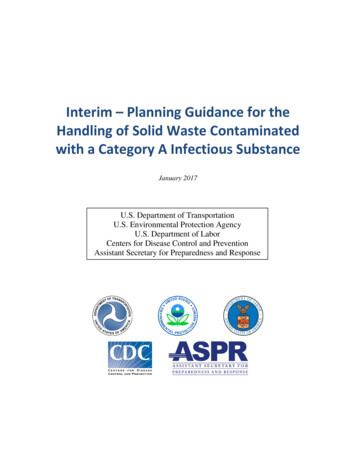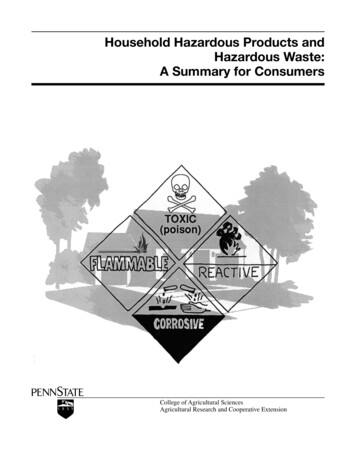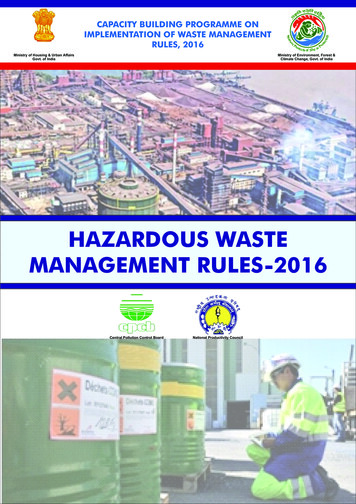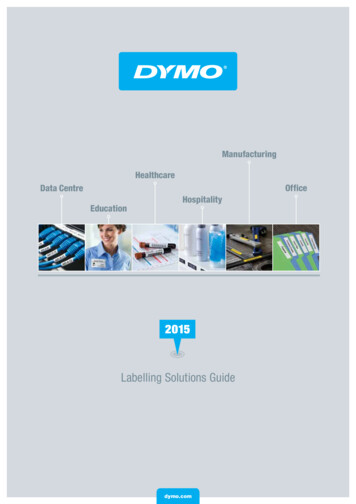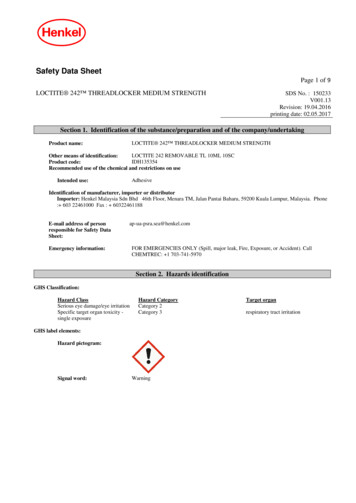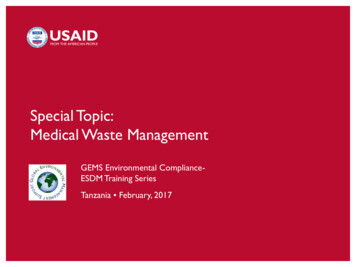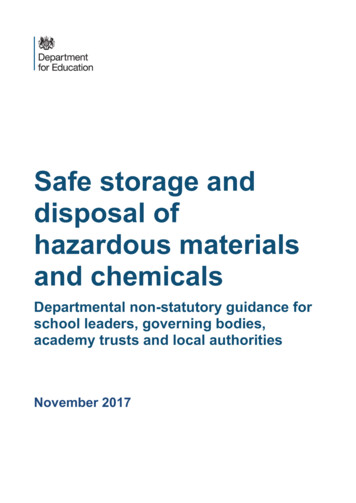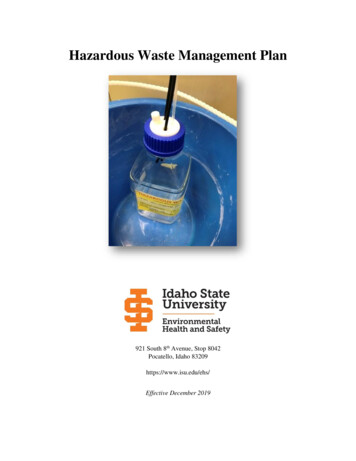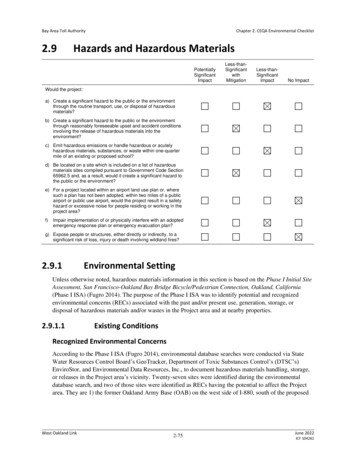
Transcription
Labelling of workplacehazardous chemicalsCode of PracticeJULY 2020
DisclaimerSafe Work Australia is an Australian Government statutory agency established in 2009. Safe Work Australia includes Membersfrom the Commonwealth, and each state and territory, Members representing the interests of workers and Membersrepresenting the interests of employers.Safe Work Australia works with the Commonwealth, state and territory governments to improve work health and safety andworkers’ compensation arrangements. Safe Work Australia is a national policy body, not a regulator of work health and safety.The Commonwealth, states and territories have responsibility for regulating and enforcing work health and safety laws in theirjurisdiction.ISBN 978-0-642-33309-4 (PDF)ISBN 978-0-642-33310-0 (DOCX)Creative CommonsThis copyright work is licensed under a Creative Commons Attribution-Noncommercial 4.0 International licence. To view a copyof this licence, visit creativecommons.org/licenses In essence, you are free to copy, communicate and adapt the work for noncommercial purposes, as long as you attribute the work to Safe Work Australia and abide by the other licence terms.Contact informationSafe Work Australia info@swa.gov.au www.swa.gov.au
ContentsForeword . 51. Introduction . 61.1.When is a label under the WHS Regulations not required? . 61.2.Who has duties in relation to labelling hazardous chemicals? . 82. Labelling hazardous chemicals – general information . 112.1.What information must be included on a label? . 112.2.Product identifier . 122.3.Disclosure of ingredients . 122.4.Manufacturer/importer information . 142.5.Label elements . 142.6.Expiry date . 162.7.Pipe work . 173. Special labelling situations . 183.1.Small containers . 183.2.Research chemicals or samples for analysis . 193.3.Decanted or transferred hazardous chemicals . 203.4.Chemicals with known hazards that are not supplied to another workplace . 213.5.Hazardous waste products . 223.6.Duplication of labelling elements . 233.7.Hazardous chemicals classified in the explosives hazard class . 233.8.Hazardous chemicals that are dangerous goods packaged for transport . 243.9.Consumer products . 253.10.Agricultural or veterinary chemical products . 263.11.Products containing nanomaterials . 273.12.Labelling of products which pose hazard a but do not meet definition . 274. Labelling design and layout . 284.1.Grouping information . 284.2.Orientation and size of label elements . 284.3.Placement . 295. Other labelling duties . 305.1.Containers found without correct labelling . 305.2.Reviewing and updating information on labels . 30Appendix A—Glossary . 32Appendix B—Checklist for preparing a label . 38Appendix C—Guide for selecting generic names . 40Establishing the generic name . 40Labelling of workplace hazardous chemicalsCode of PracticePage 3 of 136
Appendix D—Application of label elements. 52D1. Structure of hazard statement text . 52D2. Structure of precautionary statement text. 52D3. Tables of label elements from the GHS . 53D4. Additional non-GHS hazard statements . 111Appendix E—Precedence rules for label elements . 113Multiple hazards and precedence of hazard information . 113Appendix F—Hazard pictograms . 119Appendix G—Comparison of hazard pictograms with ADG class labels . 121Appendix H—Example labels . 124Amendments . 136Labelling of workplace hazardous chemicalsCode of PracticePage 4 of 136
ForewordThis Code of Practice on labelling hazardous chemicals is an approved code of practiceunder section 274 of the Work Health and Safety Act (the WHS Act).An approved code of practice provides practical guidance on how to achieve the standardsof work health and safety required under the WHS Act and the Work Health and SafetyRegulations (the WHS Regulations) and effective ways to identify and manage risks.A code of practice can assist anyone who has a duty of care in the circumstances describedin the code of practice. Following an approved code of practice will assist the duty holder toachieve compliance with the health and safety duties in the WHS Act and WHS Regulations,in relation to the subject matter of the code of practice. Like regulations, codes of practicedeal with particular issues and may not cover all relevant hazards or risks. The health andsafety duties require duty holders to consider all risks associated with work, not only thosefor which regulations and codes of practice exist.Codes of practice are admissible in court proceedings under the WHS Act and WHSRegulations. Courts may regard a code of practice as evidence of what is known about ahazard, risk, risk assessment or risk control and may rely on the code in determining what isreasonably practicable in the circumstances to which the code of practice relates. For furtherinformation see the Interpretive Guideline: The meaning of ‘reasonably practicable’.Compliance with the WHS Act and WHS Regulations may be achieved by following anothermethod if it provides an equivalent or higher standard of work health and safety thanthe code.An inspector may refer to an approved code of practice when issuing an improvement orprohibition notice.Scope and applicationThis Code is intended to be read by a person conducting a business or undertaking (PCBU).It provides practical guidance to PCBUs on how to label hazardous chemicals that are beingmanufactured or imported for use, handling or storage in Australia.This Code may be a useful reference for other persons interested in the duties under theWHS Act and WHS Regulations.This Code applies to a person conducting a business or undertaking involved in themanufacture or import of hazardous chemicals that will be used, or could reasonably beexpected to be used, in workplaces covered by the WHS Act.How to use this Code of PracticeThis Code includes references to the legal requirements under the WHS Act and WHSRegulations. These are included for convenience only and should not be relied on in place ofthe full text of the WHS Act or WHS Regulations. The words ‘must’, ‘requires’ or ‘mandatory’indicate a legal requirement exists that must be complied with.The word ‘should’ is used in this Code to indicate a recommended course of action, while‘may’ is used to indicate an optional course of action.Labelling of workplace hazardous chemicalsCode of PracticePage 5 of 136
1. IntroductionThis Code describes the type of information that is needed on labels for various hazardouschemicals so that users of these chemicals in workplaces can identify any hazardsassociated with the correct classification of the chemical and take appropriate steps toeliminate or minimise the risks.1.1.When is a label under the WHS Regulationsnot required?In general, a label is required for any substance, mixture or article classified as a hazardouschemical under the WHS Regulations. However, there are several types of hazardouschemical that are excluded from the labelling provisions under Regulation 335 of the WHSregulations or exempted from coverage from all provisions in Part 7.1 of the WHSRegulations.Chemicals labelled under the National Code of Practice for theLabelling of Workplace SubstancesWHS Regulation 341Labelling hazardous chemicals—general requirementThe 1994 National Code of Practice for the Labelling of Workplace Substances [NOHSC:2012 (1994)] was used to label workplace hazardous chemicals prior to 2017. Chemicals donot need to be labelled in accordance with the WHS Regulations if they were manufacturedor imported before 1 January 2017, labelled in accordance with the 1994 National Code ofPractice at that time and retain that label.Food and beveragesWHS Regulation 328Application of Part 7.1Food and beverage products that are packaged in a form intended for consumption do notrequire labelling under the WHS Regulations. However, large quantities must be labelled tomeet workplace requirements. For example, a 100 L container of flammable alcoholic spiritsmust be labelled to meet WHS requirements, while a 750 mL bottle of the same spirits doesnot.Therapeutic goodsWHS Regulation 328Application of Part 7.1Labelling of workplace hazardous chemicalsCode of PracticePage 6 of 136
Therapeutic goods are regarded as correctly labelled under the WHS Regulations whenlabelled in accordance with Therapeutic Goods Administration (TGA) requirements and in aform: intended for human consumptionfor intake or administration to or by a patient or consumer, orintended for use for therapeutic purposes.When not in a form intended for intake or administration to or by a patient or consumer, orfor therapeutic purposes, workplace labelling must be used.For example, a pharmacist repacks a 1 kg container of formulated tablets in smallercontainers for dispensing to patients. The 1 kg container must comply with TGA labellingrequirements. However, a 1 kg container of the same material in powdered form used by apharmacist in manufacturing or formulating products must be labelled according toworkplace labelling requirements.For more information about the labelling and packaging of therapeutic goods you shouldrefer to the information published by the Therapeutic Goods Administration(www.tga.gov.au).Agricultural and veterinary chemical productsWHS Regulation 335Labelling hazardous chemicalsAgricultural and veterinary (agvet) chemicals must meet the labelling requirements of theAgricultural and Veterinary Chemicals Code Act 1994. Where an agvet chemical is also aworkplace hazardous chemical, additional workplace labelling requirements apply under theWHS Regulations. The workplace labelling requirements for agvet chemicals are set out insection 3.10 of this Code.Veterinary chemical products are not required to meet the additional workplace labellingrequirements if they are: a veterinary chemical product within the meaning of the Agricultural and VeterinaryChemicals Code Act 1994, and listed in the Poisons Standard, Part 4 of Schedule 4, and packaged and supplied in aform intended for the direct administration to an animal for therapeutic purposes, orlisted in the Poisons Standard, Part 4 of Schedule 8.The labelling of agvet chemicals is regulated by the Australian Pesticides and VeterinaryMedicines Authority (the APVMA), who should be consulted for more information aboutlabelling agvet chemicals (www.apvma.gov.au).Cosmetics and toiletriesWHS Regulation 335Labelling hazardous chemicalsUnder the WHS Regulations, cosmetics and toiletries packaged for consumer use areexempt from workplace labelling requirements. This includes sample bottles of cosmetics atretail stores and toiletries being used at a workplace.Labelling of workplace hazardous chemicalsCode of PracticePage 7 of 136
However, when cosmetics or toiletries that are hazardous chemicals are stored, handled orused in the workplace and not packaged for consumer use, they must be labelled inaccordance with workplace labelling requirements.This includes cosmetics and toiletries in quantities that need to be repackaged, and anychemical intermediates and ingredients being used to manufacture cosmetics and toiletries.Hazardous chemicals in transitWHS Regulation 335Labelling hazardous chemicalsA chemical is in transit if it is: supplied to, or stored at, a workplace in containers that are not opened at the workplacenot used at the workplace, andkept at the workplace for not more than five consecutive days.Hazardous chemicals that are in transit do not require labelling under WHS laws. Therequirements for packaging and labelling of chemicals in transit are set out in variousAustralian transport laws and codes, including: the Australian Code for the Transport of Dangerous Goods by Road and Railthe Australian Code for the Transport of Explosives by Road and Railthe International Maritime Dangerous Goods Code, andthe Civil Aviation Safety Regulations.1.2.Who has duties in relation to labellinghazardous chemicals?The WHS Regulations apply specific duties to various persons in relation to the correctlabelling of workplace hazardous chemicals.Where a chemical is regulated under more than one set of laws it will need to meet thelabelling requirements placed upon it by all sets of laws. For example, workplace hazardouschemicals that are also agricultural and veterinary chemicals as defined in theCommonwealth’s Agricultural and Veterinary Chemicals Code Act 1994 must meet therequirements of both sets of laws.Note that under the WHS Regulations, manufacturers and importers of a substance, mixtureor article have an obligation to correctly classify that substance, mixture or article. Toprepare a correct and accurate label for a hazardous chemical, you need to know the correctclassification of the hazardous chemical.The duties in relation to labelling hazardous chemicals are summarised below.Manufacturers and importers of hazardous chemicalsWHS Regulation 335Labelling hazardous chemicalsLabelling of workplace hazardous chemicalsCode of PracticePage 8 of 136
The manufacturer or importer of a workplace hazardous chemical must ensure that thechemical is correctly labelled as soon as practicable after manufacturing or importing thehazardous chemical.This means that the hazardous chemical must be labelled in accordance with the GHS andwith Schedule 9 of the WHS Regulations.A hazardous chemical is also labelled correctly if the label includes content that complieswith another labelling requirement imposed by the WHS Regulations or by another law of astate/territory or of the Commonwealth and the content is the same, or substantially thesame, as the content that is required by the WHS Regulations.More information about correct labelling of hazardous chemicals is given throughout thisCode.Suppliers of hazardous chemicalsWHS Regulation 338Supplier labelling hazardous chemicalsA supplier must not supply a hazardous chemical to a workplace if the supplier knows, orought reasonably to know, that the chemical is not correctly labelled in accordance withregulation 335 of the WHS Regulations.Persons conducting a business or undertaking that uses,handles or stores hazardous chemicalsWHS Regulations Part 7.1 Subdivision 3Obligations of persons conducting a business or undertakingA PCBU that uses, handles or stores hazardous chemicals must ensure that any hazardouschemical that is used, handled or stored at the workplace is correctly labelled in accordancewith regulation 335 of the WHS Regulations.Additionally, they must ensure: a hazardous chemical is correctly labelled if the chemical is manufactured at theworkplace; or transferred or decanted from the chemical’s original container at theworkplace. so far as reasonably practicable, that containers are correctly labelled in accordance withregulation 335 of the WHS regulations while holding a hazardous chemical, and containers that are labelled for holding a hazardous chemical are used only for the use,handling or storage of the hazardous chemical.The three duties directly above do not apply if the hazardous chemical is used immediatelyafter being put into the container and the container is thoroughly cleaned after the chemicalhas been used, handled or stored so it is in a condition it would be in if the container hadnever contained the chemical.A PCBU must also ensure, so far as is reasonably practicable, that a hazardous chemical inpipe work is identified by a label, sign or another way on or near the pipe work.Note: a person who packages or re-labels a hazardous chemical with their own productname is considered to be a manufacturer and therefore will have the same obligations as themanufacturer or importer under the WHS Regulations to correctly label.Labelling of workplace hazardous chemicalsCode of PracticePage 9 of 136
1.3.Transition to GHS 7The Globally Harmonized System of Classification and Labelling of Chemicals (GHS) is aglobal method of classifying chemicals and preparing labels and safety data sheets (SDS).The GHS is the basis of the system used for preparing labels and SDS in Australia, and alsosets out the criteria used to determine if a chemical is hazardous.The 3rd revised edition of the GHS (GHS 3) was implemented in Australia on 1 January2012. On 1 January 2021, Australia will begin a 2-year transition to the 7th revised edition ofthe GHS (GHS 7). During the transition manufacturers and importers may use either GHS 3or GHS 7 to prepare classifications, labels and safety data sheets for hazardous chemicals.From 1 January 2023, only GHS 7 may be used.During the transition, suppliers and users of hazardous chemicals may continue to supplyand use chemicals classified and labelled under GHS 3. However, suppliers and users ofhazardous chemicals should not supply or receive stock manufactured or imported after 31December 2022 if it does not have an up to date labels or SDS under GHS 7.More information about the transition can be found on the Safe Work Australia website.Labelling of workplace hazardous chemicalsCode of PracticePage 10 of 136
2. Labelling hazardous chemicals –general informationThis chapter deals with the complete set of labelling elements that should be included on acontainer. A checklist for the preparation of a label is provided in Appendix B. In somesituations it is not possible or reasonably practicable to legibly include the complete set oflabelling elements on a label. Reduced label requirements are permitted in such situations.Guidance on the label requirements for these and other special situations is provided inChapter 3 of this Code.2.1.What information must be included on alabel?WHS Regulations Schedule 9Classification, packaging and labelling requirementsA hazardous chemical is correctly labelled if the chemical is packed in a container thatincludes the following: is written in Englishthe product identifierthe name, Australian address and business telephone number of either the manufactureror importerthe identity and proportion disclosed, in accordance with Schedule 8 of the WHSRegulations, for each chemical ingredientany hazard pictogram(s) consistent with the correct classification(s) of the chemicalany hazard statement(s), signal word and precautionary statement(s) that is consistentwith the correct classification(s) of the chemicalany information about the hazards, first aid and emergency procedures relevant to thechemical, which are not otherwise included in the hazard statement or precautionarystatement, andthe expiry date of the chemical, if applicable.As a person conducting a business or undertaking (PCBU), you may include any informationon the label that does not contradict or cast doubt on any other information that is requiredon the label.The following additional information should also be included on the label, where available: an emergency phone number for specific poisons or treatment advicethe overseas name, address and telephone number of the manufacturer or suppliera valid website or internet addressreference to the safety data sheet, for example a statement on the label that says:‘Additional information is listed in the safety data sheet’.If an emergency information service or Poisons Information Centre phone number isprovided on the label, this arrangement should be confirmed with the service beforehandand copies of the SDS should be provided to them.Labelling of workplace hazardous chemicalsCode of PracticePage 11 of 136
2.2.Product identifierA product identifier is a unique name or number by which the chemical is to be known, andwhich allows the product users to identify the hazardous chemical. The product identifiermust be the same as that listed in the safety data sheet, and may be identical to the tradename.The product identifier and details of ingredients should be grouped together and located atthe most prominent position on the label, for example at the top or centre of the label, or on afront panel.2.3.Disclosure of ingredientsWHS Regulation Schedule 8Disclosure of ingredients in safety data sheetThe chemical identity of an ingredient must be disclosed on the label in accordance withSchedule 8 of the WHS Regulations (Disclosure of ingredients). In some cases, a genericname may be used.Disclosure of ingredient names is not required by the WHS Regulations for those ingredientsthat meet only physical and/or environmental hazard classifications, or for non-hazardousingredients.The identity of ingredients for the following GHS health hazard categories do not need to bedisclosed because they are outside the scope of the WHS Regulations: acute toxicity—Category 5 (oral, dermal and inhalation)skin corrosion/irritation—Category 3aspiration hazard—Category 2aquatic toxicity (all categories)flammable gases—Category 2, andozone depletion.Use of generic namesA generic name may be used to identify an ingredient if the identity of an ingredient isgenuinely commercially confidential, and if: the ingredient is in any of the following health hazard categories: acute toxicity—Category 4 (oral, dermal, inhalation)aspiration hazard—Category 1serious eye damage/eye irritation—Category 2skin corrosion/irritation—Category 2, orspecific target organ toxicity (single exposure)—Category 3.the ingredient does not cause the correct classification of the hazardous chemical toinclude any other hazard class or category within table 8.1 of the WHS Regulations, andan exposure standard for the ingredient has not been established.A guide for selecting generic names for ingredients is included in Appendix C of this Code.Labelling of workplace hazardous chemicalsCode of PracticePage 12 of 136
Unknown or variable composition mixtures and complexreaction productsIt may be difficult to identify the ingredients of certain complex mixtures. These includenaturally occurring gases and oils, and complex reaction products. These products maycontain several hundred unique ingredients and their composition may vary betweenbatches.A single technical name may be given to such chemicals, though as much ingredientinformation should be included on the label as is reasonably practicable. This may includethe chemical families and subfamilies present in the hazardous chemical, and the ranges inwhich they are expected to be present.Disclosing proportions of ingredientsFor multiple ingredients, proportions should be listed in descending order by mass orvolume. Ingredients not contributing to the hazard classification should also be listed, andwhere included, should be listed after the ingredients contributing to thehazard classification.However, where the exact concentration of an ingredient is commercially confidential, theconcentration of the ingredient can be disclosed using the following ranges: 10%10 – 30%30 – 60% 60%The proportion of an ingredient should normally be disclosed using a narrower range, forexample, for an ingredient present at 35%, a range of 30–40% should be used insteadof 30–60%.Where possible, the percentage composition should add up to or indicate a total of 100%,even if an estimate of non-hazardous ingredients needs to be provided.Where the chemical identity or generic name of an ingredient that makes up a hazardouschemical is disclosed, the proportions of the ingredients must also be disclosed in an SDS.Example of how ingredients can be represented on a labelFlammable Liquid A contains the following ingredients: TolueneEthyl methyl ketoneMethanol2-butanolXylene55%40%3.5%1%0.5%As both xylene and 2-butanol are not hazardous to health at these concentrations, they arenot required to be disclosed in the ingredients section of the label. However, as they bothhave exposure standards it is good practice to disclose them both on the label.The ingredients and their proportions may be disclosed on the label using the exactproportions:Flammable Liquid A contains: TolueneEthyl methyl ketoneMethanolLabelling of workplace hazardous chemicalsCode of Practice55%40%3.5%Page 13 of 136
Non-hazardous ingredients1.5%If the ingredient proportions are commercial-in-confidence, they may be disclosed on thelabel using a range:Flammable Liquid A contains: TolueneEthyl methyl ketoneMethanol2.4.30 – 60%30 – 60% 10%Manufacturer/importer informationThe label must include the Australian contact details of the manufacturer or importer. Therequired contact details include the manufacturer or importer’s name, Australian address andbusiness telephone number.Additional information, including details of an overseas manufacturer or supplier—forexample a website or internet address—may be included on the label.The manufacturer or importer identification may be provided in a less prominent position onthe label, for example the back portion of the label. It should be grouped with the expiry date,where applicable.2.5.Label elementsThe combination of label elements required on the label of a hazardous chemical is directlylinked to its hazard classification. Label elements apply to hazard categories and must bedetermined as specified in the GHS.Appendix D includes tables listing all the elements that apply to each hazard class andcategory or division.The signal word, hazard pictograms and hazard statements should be grouped together in aprominent position on the label, and located either immediately following or adjacent to theproduct identifier and chemical ingredients.Some non-hazardous chemicals may still pose a risk to people or the environment, forexample dry ice (solid carbon dioxide). These chemicals will not have hazard pictograms,hazard statements, signal words or precautionary statements; however, their labels for theseproducts should include information on their hazards and safety precautions. For example,the label for dry ice should include information on the asphyxiation hazard and precautionsfor handling to avoid cryogenic burns.Labels should be suitably durable to remain clear and legible throughout the expected life ofthe product, and to minimise the risk of labels being eroded by the contents of the container.Labelling of workplace hazardous chemicalsCode of PracticePage 14 of 136
Signal wordsSignal words are used to indicate the relative level of severity of a hazard. The GHS uses‘Danger’ and ‘Warning’ as signal words. ‘Danger’ is used for a more severe or significanthazard, while ‘Warning’ is used for the less severe hazards.Only one signal word should be present on any one label. If the signal word ‘Danger’ applies,then the signal word ‘Warning’ should not appear on the label.Signal words should be represented in bold and upper-case text.Hazard statementsHazard statements describe the nature of a hazard, including the degree of hazard, whereappropriate. A unique hazard statement is assigned to each hazard class and category. Thehazard statements and corresponding hazard class and category are p
Code of Practice Page 5 of 136 . Foreword . This Code of Practice on labelling hazardous chemicals is an approved code of practice under section 274 of the . Work Health and Safety Act (the WHS Act). An approved code of practice provides practical guidance on how to achieve the standards of work health and safety required under the WHS Act and the

